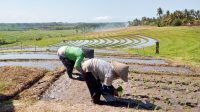- MORNING covered with cold atmosphere, especially around the new moon, in March will be an important moment for fishermen or estuary anchovy seekers. They are willing to break through the morning and reduce sleep time to get that transparent delicious little fish.
Early in the morning every new moon falling around March, anchovy seekers are usually on standby with equipment on the beach or estuary. They flock to greet the arrival of anchovies from the sea through the rolling waves.
They carry shovel-type fishing gear along with bamboo baskets or bamboo basket as containers. Some are big and some others are small. Since these anchovies usually head for rivers or fresh water streams, they flock to river mouths. Well, this is where they are intercepted by anchovy seekers.
In general, anchovies go to the mouth of the river following the sea waves. The series of waves that pull over then become a ride for the anchovies. The anchovy seekers are like competing to get the most catch. On average, they wake up around five or four in the morning because the sky is clear so they are already at the ‘target location.’
The anchovies are the ‘fingerlings’ of small fish such as beboso (fully black), lemiras (spotted fish in sandy areas) and uduhan (like adhering to stone’s surface underwater). After entering an estuary or river area, they quickly grow in size, from clear or transparent white to slightly darker or approaching the shape and color of adult fish.
In season, fishermen will always try to find information where broken anchovies are found. Every river mouth will be monitored. Some even stay overnight at the mouth of the river. If they’re lucky, they’ll find anchovies sleeping in a bunch. Of course, this is very easy to catch and also means a big fortune for them.
Another way
Apart from blocking it with fishing net (with smallest holes), they also use other methods such as making the main canal with a temuku (water feature) with a height of about 30-40 cm. With this altitude, the small anchovies (3-6 days old) will not be able to get past the water feature. Then, on the left or right side near the canal, a trap canal will be made in the form of a smaller canal whose stream is connected into a gauze bag (same material as fishing net above).
Well, in this way the anchovies that are going to head upstream of the river would be trapped and drifted into the gauze bag. In other words, if anchovies escape from being caught by fishermen on the beach or estuary, they will be caught in this trap canal (begbegan).
Anchovy dish
How to process it? There are many ways to cook fresh anchovies into delicious dishes. Firstly, by simply frying it with simple seasonings such as sliced shallots, garlic and chili with a pinch of salt.
Secondly, with the same spices as above plus turmeric, aromatic ginger and greater galangal and grated coconut where all ingredients are ground, the fresh anchovies are then sautéed in a little water and wait until the water runs out. If you want a dry nuance, the mixture above without water is wrapped in banana leaves and then grilled to get pepes anchovies. Well, now you just have to choose which way to prefer. Of course, both are delicious, but the taste is slightly different.











